 Washington Trails
Association
Washington Trails
Association
Trails for everyone, forever
WTA’s trail maintenance program has evolved over the years, but continues to focus on the values of community originally envisioned by its founders. | By Anna Roth
WTA’s trail maintenance program celebrates its 30th anniversary this year. Since our first work party, hikers have contributed millions of volunteer hours, maintaining access to Washington’s signature trail network.
That incredible achievement is thanks to the commitment, innovation and creativity of the people who showed up to make it happen — from the founders of the program to the volunteers who step up daily. It’s also due to our dedication to finding creative solutions to challenges, whether that means making custom tools, evolving our work parties to welcome more people or creating a springboard to jobs in the environmental industry.
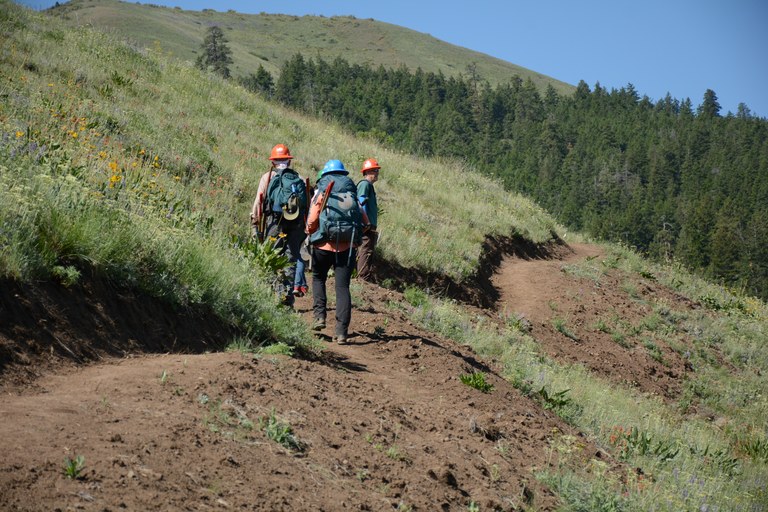
WTA volunteers walk to a work site at Manastash Ridge. This trail uses reverse grade, which helps water flow off and preserves the life of the trail. Photo by Anna Roth
Washington Trails Association began as Signpost magazine, which was founded by Louise Marshall in 1964. Several years later, Louise teamed up with board member Ira Spring to leverage Signpost to represent hikers and get funding for trails.
The advocacy effort was generally successful, but by 1993 WTA membership was flagging and Greg Ball, the executive director, knew he needed to attract new membership. Ira had been a longtime trail maintenance advocate and Greg decided to get some hands-on trail maintenance experience.
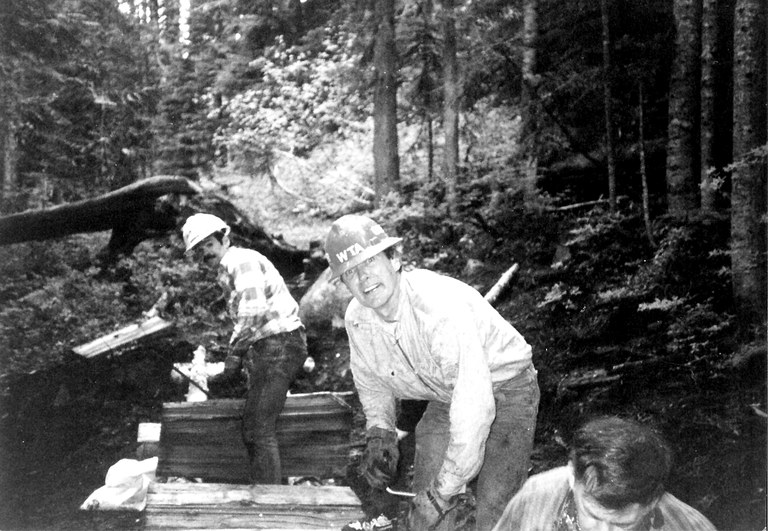
Greg Ball helped create WTA’s trail maintenance program as the Forest Service’s budget was being cut. Photo courtesy of WTA archives
After learning some trail skills with Volunteers for Outdoor Washington, Greg got the idea that an all-volunteer trail maintenance crew could support the Forest Service as its maintenance budget dwindled. It would also help show potential members the value of WTA.
Greg set up meetings with Forest Service employees in 1993 to pitch the idea. His background was in banking, so he asked John Spring, Ira Spring’s son and a longtime National Park Service employee, to join him.
Our first work party was arranged by a board member in Vancouver, Washington. She was part of an outdoor group that wanted to do trail work, and John recalled talking to Greg on the drive home to Seattle from that work party.
“Greg and I decided that trip was successful, but we needed to tap into a more local volunteer pool, which was why Kathy White and Tom Davis were our next stops to set up work parties.”
The Forest Service welcomed the offer of assistance. Kathy, who at the time was the trail manager for the Snoqualmie Ranger District, remembers their first meeting.
“We (the Forest Service) were getting pretty burnt out. Greg and John and Becky Hope from Back Country Horsemen of Washington came to us one day and asked what the Forest Service needed,” Kathy said. “We said, ‘crew leaders!’ We needed people we could trust to make reasonably good decisions about what to do and what not to do — mostly from a safety standpoint — and could help us lead projects.”

WTA has refined our techniques over the years to let us get more work done. One of the ways we do that is with ziplines. Using these lines makes it easier to move materials and protects the landscape because volunteers, like this youth crew, have to take fewer trips. Photo by Kesia Lee
Tom Davis, the district ranger at the Skykomish Ranger District, was fairly new to the Forest Service when he met with Greg and John for the first time.
Greg and John had a strong pitch, and the Forest Service was willing to give it a shot, so Gary Paull, the wilderness and trails program coordinator for the Mt. Baker-Snoqualmie National Forest, drafted up an agreement to get the program going.
Since the district rangers were concerned about volunteer safety (now one of our three pillars of a successful work party) there were guidelines.
For the first few years of the program, WTA crews had to have a Forest Service employee supervise all work parties. And they had to work according to Forest Service maintenance standards — a standard we still abide by.
Initially, work parties were shared in Signpost. When Bill Sunderland, a WTA supporter and board member, saw the potential of the internet, he created wta.org. It was the beginning of our online Hiking Guide and trip reports, and made it much easier for volunteers to register for work parties.
As participation skyrocketed, Greg and John welcomed new volunteers. WTA gained on-trail experience and began working on more complex projects, like building bridges and other structures.
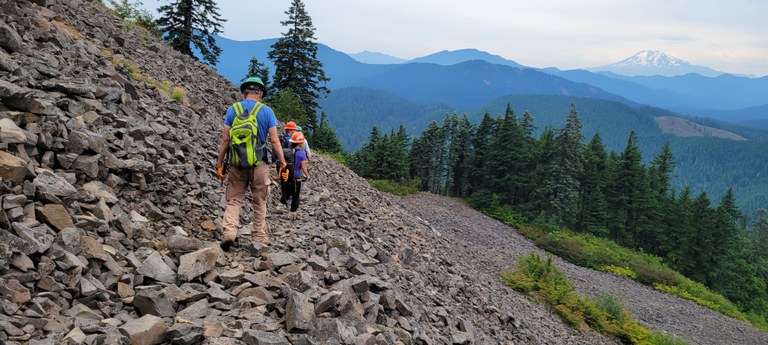
At the same time, trail maintenance budgets continued to decrease, so the challenge became finding ways to make trails with fewer structures. Structures are expensive and time-consuming to build and can require a lot of upkeep. Sometimes they can’t be avoided, like bridges at creek crossings or stairs on a steep trail. But trail structures are commonly used to manage water, and it’s often possible to build a trail that water naturally flows off of, instead of building a drain that might clog. It’s a tactic that had been used in hard-to-access backcountry areas but WTA started applying it in closer-in areas as well.
We’ve also gotten creative with our tools. As a nonprofit responsible for delivering hundreds of thousands of hours of trail work a year, we’ve been resourceful to stretch our funds. That means figuring out how to make tools last as long as possible, including hosting tool-sharpening work parties and having volunteers help clean tools at the end of the day, both of which prolong tool life. Some innovative volunteers have even created specific tools.
As the WTA trail maintenance program grew, we formalized a leadership structure and incorporated trainings to turn volunteers into crew leaders. We had the philosophy that anyone who wanted to should join a WTA work party. We love a good dad joke, and a popular phrase you’ll hear is that WTA stands for We’ll Take Anyone. But a few years ago, we realized that this broad invitation wasn’t enough. Trail work jargon can be confusing and an 8-hour day can be a lot to commit to when you’re not even sure what the project is or if you’ll have fun.
We started offering work parties intentionally designed to help people overcome the unknowns that were keeping them from volunteering.
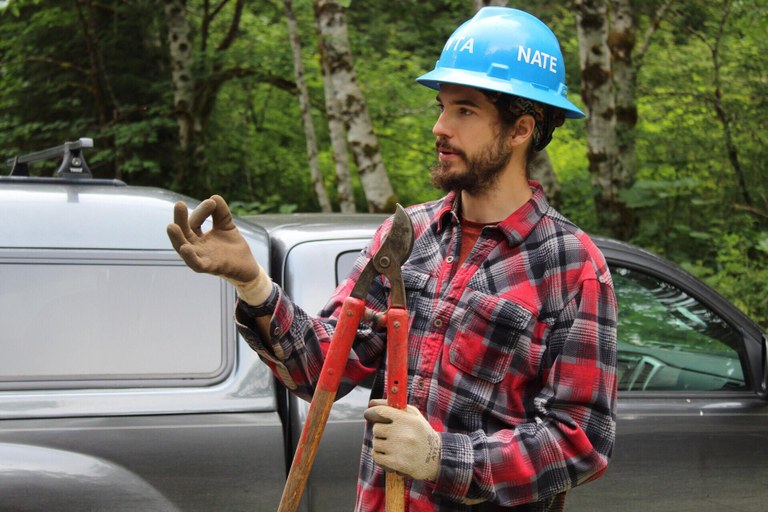
Nate Schmidt, a WTA crew leader, gives a safety talk before a work party. Safety and community are two staples of each work party. Photo by WTA staff.
One of our first steps was to expand our shared-identity work parties. For years we had hosted all-women backcountry trips, but in 2018 we added LGBTQ+ trips, and later other shared-identity trips were added. We also began offering youth (for kids 10 and older) and family trips that start later in the day and are just 4 to 5 hours long.
A guiding principle of WTA is that people who spend time on trails will steward them, so it’s important that the next generation develop that connection early. Tom Davis — the Forest Service employee we began our program with — understands that philosophy. “Trails, as you know, are long-term things. Most of the trails you work on are over 100 years old, and they’re going to be there 100 years from now.”
WTA employs a lot of people. Annually, we hire a cohort of seasonal crew leaders to supplement our volunteer crew leaders. In recent years, we’ve begun hiring many more people per season to keep up with demand, and we wanted to ensure we were reaching and employing a diverse group of people who represent Washington’s trail community. Hiring like that takes intentionality. So we developed a program to help interested people get a foot in the door.
In 2019, we established our Emerging Leaders Program (ELP). Participants get a holistic introduction to the work WTA does, from communications to trail work. ELP gives participants work experience and a network of professional contacts they can use as a springboard to a job in the environmental industry. Many ELP alumnae have gone on to full-time work at our partner organizations, and some work full-time at WTA, in various roles.
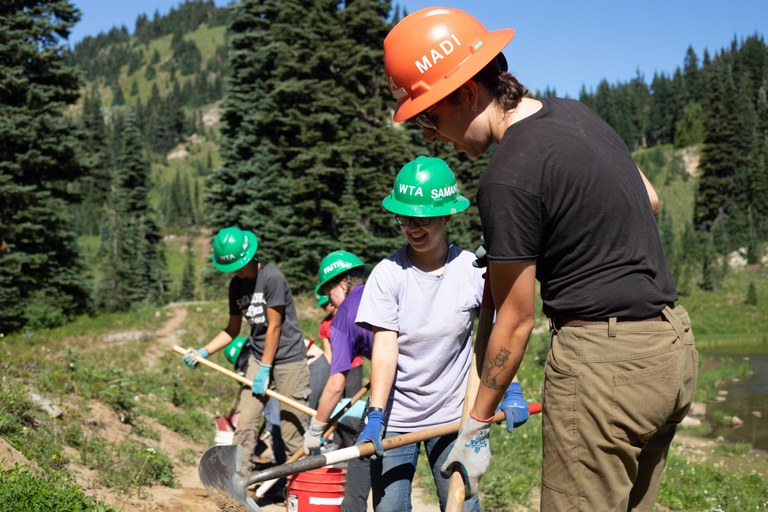
Providing space for development and inclusion are key priorities of WTA's trail maintenance program. Photo by Kesia Lee
Thirty years later, WTA’s trail maintenance program is so much bigger than Greg Ball’s original vision.
Greg died in 2004, but John Spring, who is still active in the trail world on a national level, attended this year’s Crew Leader College and spoke to the crowd of crew leaders and volunteers.
“When Greg and I started this, we would have been happy to have a couple other people with us,” he told the volunteers. “I think if he was here today, he’d be shocked at how many of you there are … Thank you for helping build one of the best programs in the United States. We wanted to do trail work, but the most important thing was to get volunteers to come back again and again. And nationwide, WTA is the envy, not only for the quality (of work), but for the number of people who come back for that second time and third time.”
Clearly, John and Greg did something right on those first work parties, and we’re continuing that legacy. People come back repeatedly, some hundreds or even thousands of times, thanks to 30 years of innovation, creativity and passion. Whatever the next 30 years bring to Washington’s trails, we’ll be there, working in the dirt.
If you’ve been on a work party with us, thank you for helping to care for trails. If you haven’t yet, we can’t wait to see you!
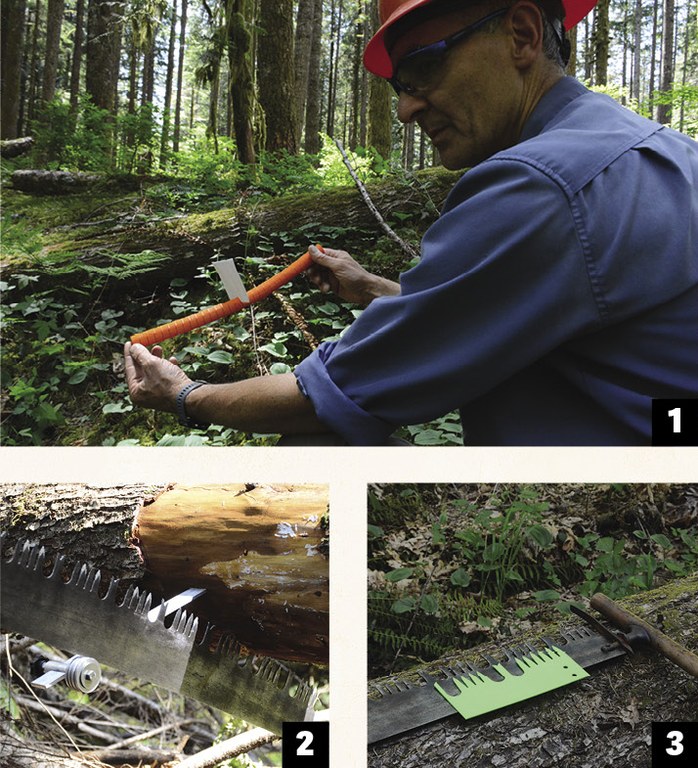
Photos by Kesia Lee, Anna Roth
Slice the tip off an old or nicked shovel, bend it 90 degrees, and you’ve got a Rhino, a tool that makes tread building a breeze.
For detail work, look to the McGrubber, a small tool created by a volunteer on the Olympic Peninsula. It’s a crooked piece of metal that helps you get in between the small, hard-to-clean roots of a tree that needs to be removed.
For logouts, we have the underbucker (2), made for WTA by Jeff Wright, a Puget Sound area volunteer. This nifty little piece of metal attaches to a tree so that crosscut saws can rest in it as the tree is sawed from the bottom up.
With crosscutting and logouts, it’s important to evaluate the potential dangers in a downed log before cutting. Volunteer Simon Lie created a fantastic, lightweight model log (1) that helps sawyers visualize where a tree is bound (under tension), which is a major safety factor. He even made a small section of a crosscut (3) that can be mounted on a real crosscut handle so new sawyers can see how the teeth and rakers work without the risk of cutting themselves.